Image above by Kevin from The Beginning at Last

Beer Styles
Look at that happy and friendly beer muse above. That is Kevin’s picture. Wouldn’t you like a beer? I like beer and I also brew beer at home. My dog Rollo loves it when I spill wort on the kitchen floor. The wort is what you have before fermentation. It is like a grainy sticky sweet soup, and he likes to lick it up. However, my wife does not like it when there’s sticky wort all over her kitchen floor and the stove. Everyone has their own perspective.

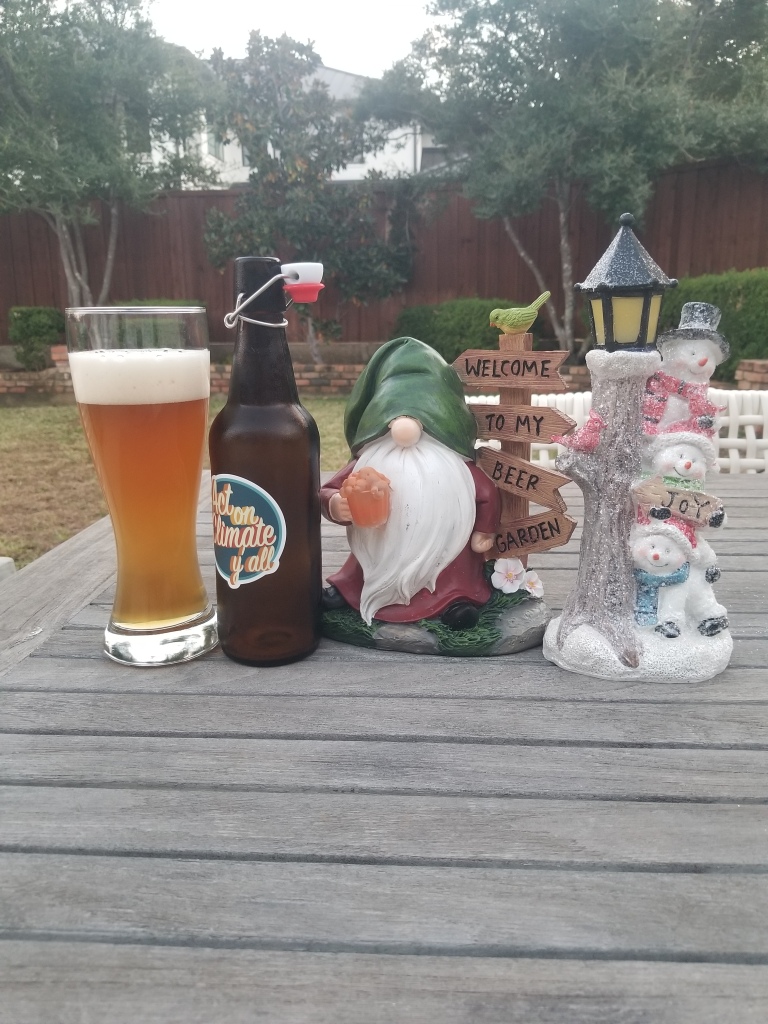
Beer is one of the oldest alcoholic beverages in the world, dating back over 7,000 years to ancient Mesopotamia. There are more than 100 different styles of beer worldwide, with the main categories being lagers and ales. The beer advocate currently lists 120. Below are a few examples of Lagers and Ales.
Lagers : Pilsner, Märzen (Oktoberfest), Adjunct Lager, Pale Lager, Scwarzbier (a black lager), Bock.
Ales : IPA, Stout, Porter, Wheat Beer, Belgian Beer, Blonde Ale, Saison, Barley Wine, Lambic, Geuze
Brewing Beer at Home
When you brew beer at home you start by boiling the wort. You boil water and you add the malts and the hops for the flavoring and the aroma at specific times. This all depends on the recipe you are following. Warning! The wort easily boils over. Then you cool the wort (I use an ice bath to do this), add the yeast, and you let it ferment, typically for a couple of weeks.
You can add various things for flavoring, such as whiskey infused wood chips if you want your beer to have a taste of whiskey and wood (yes, I have done that). Whiskey and wood are great added flavors in stouts. After the two weeks of fermentation, you add sugar and bottle the beer and let it ferment for a few weeks before you put it in the fridge.
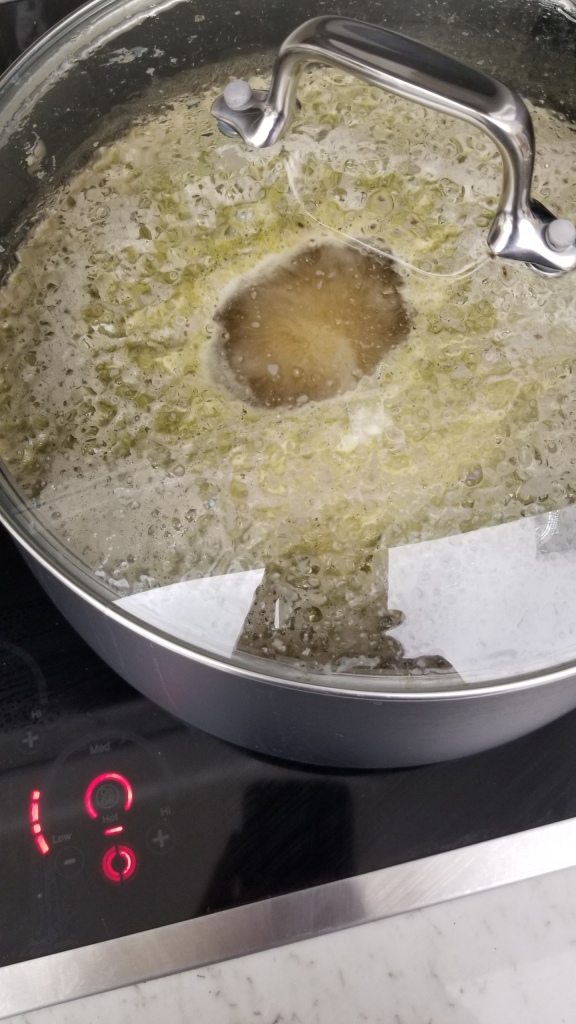
A few words about the bottling process. The bottling process below is using siphoning instead of pouring to achieve some filtering and to avoid splashing. Splashing can cause excessive oxidation which can ruin the beer the same way bananas turn brown. This seems to matter for New England style IPAs, but not so much for other beer styles (my observation).
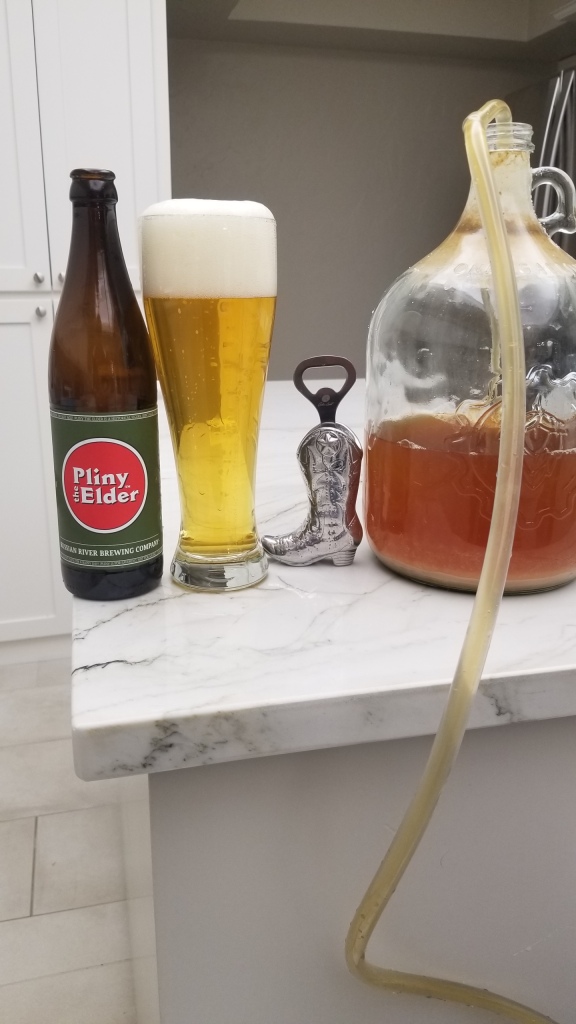
Measuring the alcohol content in home brews
When you brew beer at home you don’t have the advanced equipment that breweries sometimes do so measuring the alcohol content is a challenge. However, you can do it with an indirect method using a hydrometer. I will explain how to do this. There are instruction booklets, books and online websites that explain how to do this, but I will keep it short and succinct.
During the fermentation process, yeast converts sugars into alcohol (and carbon dioxide). As the sugar is used up, the wort slowly becomes less dense. By measuring the density before and after fermentation (using the hydrometer), you can calculate how much alcohol is in the finished beer. In the beer world this is called measuring the gravity, not to be confused with the fundamental force of attraction between objects with mass. You can buy a hydrometer in a lot of places including Amazon.
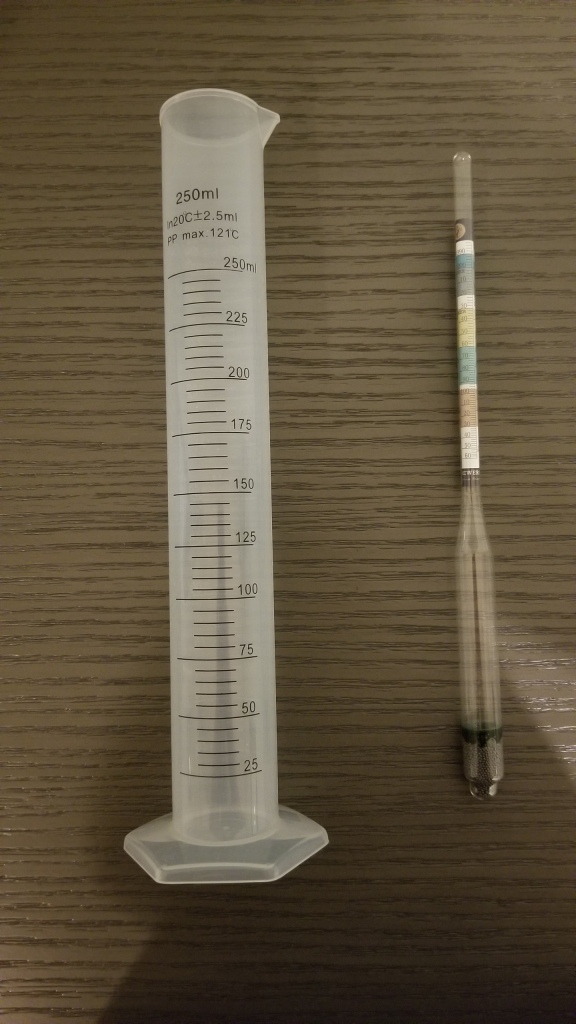
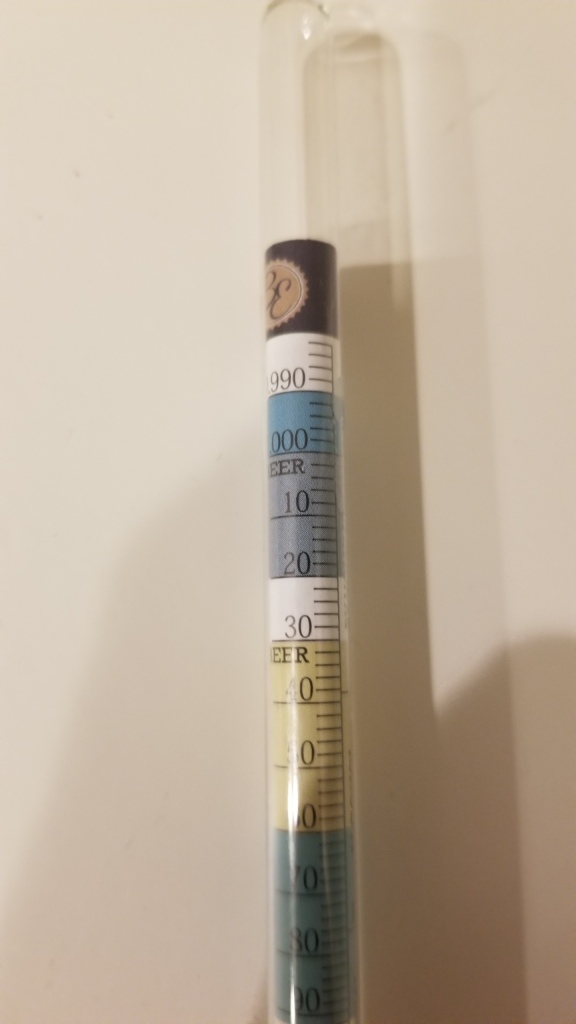
The density/gravity of water is used for reference as 1.000. To be exact, it also depends on the temperature, but for now we’ll ignore that. After the initial boil of the wort, and before you add the yeast, there is no alcohol in the wort. This is a good point to measure what is called original gravity (OG).
I should mention that you need to let the wort cool off before doing your measurement. The temperature at this point should be around room temperature, 72 degrees (60 to 75 degrees). Then after fermentation (in your container, carboy, whatever) you measure it again. This is called the final gravity (FG).
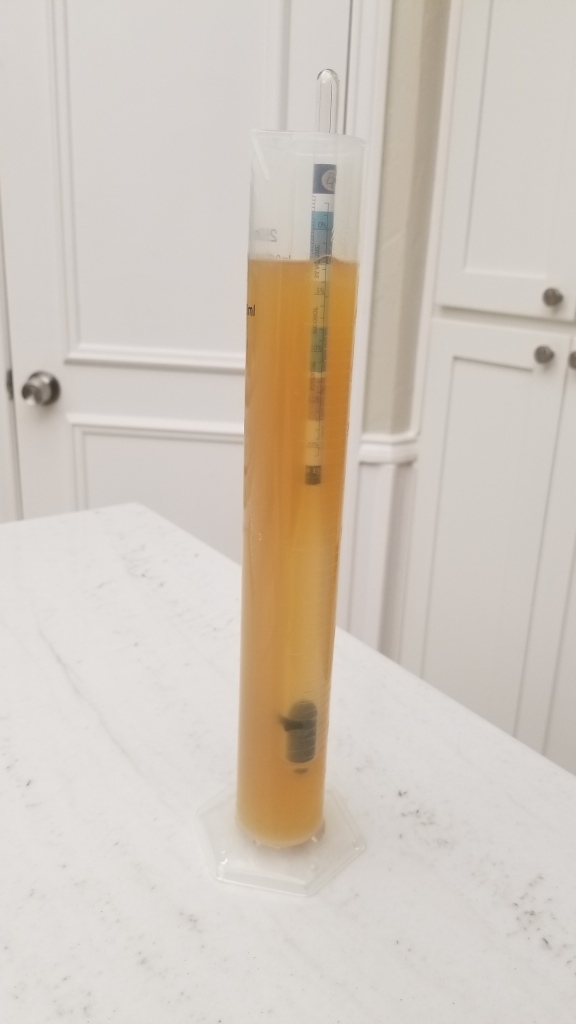
I should add that after the fermentation in your container/carboy is done you add a little bit more sugar (called priming sugar), you bottle the beer, and you let it ferment a little bit more, which will add a little bit more alcohol as well as carbon dioxide. You want some carbon dioxide in the beer but not too much. This extra amount of alcohol is not accounted for using the final gravity. However, it is typically around 0.2% and if you wish to include it, you can just add that number.
Using the original gravity (OG) and the final gravity (FG) you can now calculate the ABV, Alcohol by Volume, by using the formula below. For this brew, an IPA (India Pale Ale), I got OG = 1.072 and FG = 1.018. Ideally FG is around 1.010, but for whatever reason I did not get there.
ABV = (OG – FG) x 131.25 = 0.054 x 131.25 = 7.1%
So that would be 7.3% with the bottle fermentation. That is a good enough measurement, but if you want precision, there is a more exact formula.
ABV = (76.08 x (OG – FG) / (1.775 – OG)) * (FG/0.794) = which in my case yields ABV = 7.23% which would yield 7.43% with the bottling. I can add the recipe predicted ABV = 7.5%. There are even more exact formulas that account for the temperatures at the points of measurement of original gravity and the final gravity. But that would be really nerdy.


I used to know nothing about home brewing. Thank you for fixing that.
LikeLiked by 1 person
Ha ha thank you Jacqui. Maybe you will brew some beers too.
LikeLiked by 1 person
I’ll be right over, keep one cold for me! 😊 Maggie
LikeLiked by 1 person
Ha ha thank you Maggie. I’ve got lots of beer.
LikeLike
How cool Thomas, I have never tried to self-brew beer. The finished product looks great and is making me thirsty, I can well understand and indeed see (look at those eyes) Rollo’s desperation to get in on the action. I enjoyed reading about the processes involved, mist of which was either new to me or I’d forgotten from the many brewery tours I’ve taken over the years.
LikeLiked by 1 person
Thank you so much Leighton. Sometimes it comes out good, like my last IPA, but sometimes it is not great. I’ve had a New England style IPA oxidize fairly quickly (must have splashed it during bottling), and my latest Hefeweizen / wheat beer had the problem with half the bottles being flat. It has been suggested to me that the cap on some of my bottle are leaking. Professional breweries don’t worry about these things.
LikeLiked by 1 person
Hi Thomas, this is an interesting post. I did some research on making beer when I wrote The Christmas Bird.
LikeLiked by 1 person
Yes I remember that. It was very interesting to learn about the beer they brewed. I forgot the name of it at the moment. There are many interesting beer brewing traditions around the world. It is too bad so many people think of beers as bud light.
LikeLike
I would not expect you to remember the name Umqombothi. It is very African 😁
LikeLiked by 1 person
Ha ha yes that is not easy to remember for a Swede/Texan
LikeLike
😊
LikeLiked by 1 person
Wow! That’s cool about home brewing! 🙂
LikeLiked by 1 person
Thank you so much Kymber. It is a little hobby.
LikeLiked by 1 person
This brings back many good memories. It’s been several years since I’ve brewed a batch of beer. I need to clear some days on my calendar and brew a batch again. I sent two of my beers to the state fair in New Mexico and they both won silver medals. One was a porter and the other was a smoked ale with chipotle peppers added for flavoring.
LikeLiked by 1 person
Yes I remember you mentioning that and that is pretty awsome. I am pretty far from being that advanced with my home brewing.
LikeLike
Incredible, Thomas. I had no idea! I will share your post with my sons.
LikeLiked by 1 person
Thank you so much Gwen
LikeLiked by 1 person
A few notes.
First, this is fascinating, as I know nothing about home brewing. I have considered trying it, but have not yet!
Second, that whiskey and wood beer sounds excellent!
Finally, Rollo is beautiful!
Thank you, Thomas. I truly enjoyed this!
LikeLiked by 1 person
Thank you so much Kevin for your very kind comment
LikeLiked by 1 person
My pleasure, Thomas. I hope you are having a great week thus far. 😊
LikeLiked by 1 person
I hope you are having a great week too
LikeLiked by 1 person
It could be better but it could be far worse too 😄
LikeLiked by 1 person
That’s much more complicated than I expected, Thomas, and it involves math! Oh no. Hehehe. But what a fun hobby, especially if it comes out well. I’ve made (undrinkable) wine before, and I do ferment a decent kombucha, which requires no special skills. Cheers!
LikeLiked by 2 people
Thank you so much Diane. Brewing beer isn’t very difficult and involves hardly any math, but trying to measure the alcohol does. That’s why I don’t do that part very often.
LikeLiked by 1 person
Oh, that makes sense. My husband needs a hobby …. hmmm.
LikeLiked by 1 person
I wish your husband the best of luck
LikeLiked by 1 person
I both read and watch a lot of historical fiction, and I am always amazed by the amount of ale consumed. I had no idea of what was involved in the home brewing process having only ever seen the elaborate processes in retail brewery outlets, so this was of great interest. Thank you for this play by play. I really enjoyed it.
LikeLiked by 1 person
Thank you so much for your kind words Violet. Ales were often safer to drink than water back in the day because you boiled the wort. There were so many kinds of Ales with so many different flavors. Then came the Lager, which is a great invention but the pale mass produced lagers became so popular that the Ales with all their variety of flavors and types are being forgotten a bit.
LikeLiked by 1 person
Fascinating to learn about the beer making process. I know you are a beer connaisseur. 🙂 I personally don’t drink beer so thanks for the info. 🙂
LikeLiked by 1 person
Thank you Debby. Maybe you like wine? Some people make wine at home.
LikeLiked by 1 person
I do like wine. And I’ve had a few homemades from friends and their parents through the years. I don’t recall enjoying any homemade wines though. 🙂
LikeLiked by 1 person
Well I had people telling me they liked my homebrewed beer, but you never know.
LikeLiked by 1 person
Being the connaisseur you are, I have no doubts your beer is delish – to beer lovers. 🙂
LikeLiked by 1 person
Thank you so much for your kind words Debby. Hopefully, they are not just saying it to be nice.
LikeLike
Lulu: “Hmm, I think licking sticky sweet stuff up off the floor sounds like the perfect job for a dog, and dogs like to have work to do. Seems like both you and Rollo win in this situation!”
LikeLiked by 1 person
You are Lulu. The floor is cleaned before my wife sees the mess and Rollo loves that kind of work.
LikeLike
Where I work, we have a client that makes yeast that’s used in home-brewing (professional breweries use it too). I never got into home-brewing myself though. Kind of in the same way I never had the urge to bake my own bread, I never had the urge to brew my own beer. The people who are into it are really into it, though! Kind of like how the people who bake bread are really into baking bread. Maybe it’s a yeast thing. 😉
LikeLiked by 1 person
A Yeasty thought. You are right it is kind of like baking bread but slower. The yeast is quite important and type of yeast you use can result in a lot of different flavors. It is not just the hops. Some yeast result in a lot of esters, which in general you don’t want unless you get the right yeast for that. You get banana flavored esters when you brew with wheat and the right yeast (in wheat ales like Hefeweizen and Witbier) and you fruity and tart flavors with wild yeast when brewing Lambics, Geuze, and other Belgian fruity style beers.
LikeLike
Fascinating to learn about home brewing! You are obviously an expert, Thomas. Thanks for sharing your process.
LikeLiked by 1 person
I am not an expert but I appreciate your kind comment Debbie.
LikeLiked by 1 person
Rollo is super cute as always! ☺️ the home brewing process you showcase here is absolutely fascinating and it makes me want to try it myself someday!
LikeLiked by 1 person
Home brewing is fun and not that complicated. Measuring the alcohol is a bit more of a challenge, but you do not have to do that.
LikeLiked by 1 person
Love Rollo. The whisky and wood flavouring sounds amazing.
LikeLiked by 1 person
Thank you so much KC. Yes if you like flavored stouts it is/was pretty good.
LikeLiked by 1 person